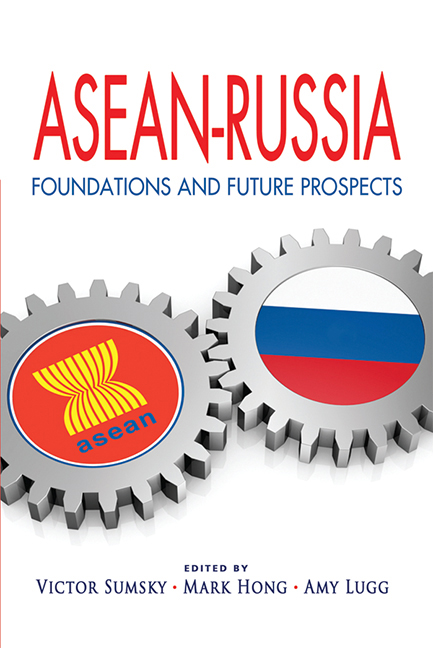Book contents
- Frontmatter
- Contents
- Foreword
- Preface
- About the Contributors
- Keynote Address
- Opening Remarks
- Keynote Address
- Introduction: Russia and the ASEAN Member States: Political and Economic Cooperation in Progress
- SECTION I WISEMEN'S VIEWS
- SECTION II GEOPOLITICS
- SECTION III BILATERAL RELATIONS
- SECTION IV Business and Economics
- Russia and ASEAN-4: Potential and Realms of Cooperation
- Russia's Economic Relations with the APEC Region
- Russia Looks East: Modernization Plans and Cooperation with ASEAN
- Indonesian and Russian Oilmen: Sharing Experiences and Learning from Each Other
- Towards a Roadmap for Russia-ASEAN Trade and Economic Cooperation
- The Best Cities to Buy Into
- SECTION V CULTURE AND EDUCATION
- EPILOGUE
- Index
Russia Looks East: Modernization Plans and Cooperation with ASEAN
from SECTION IV - Business and Economics
Published online by Cambridge University Press: 21 October 2015
- Frontmatter
- Contents
- Foreword
- Preface
- About the Contributors
- Keynote Address
- Opening Remarks
- Keynote Address
- Introduction: Russia and the ASEAN Member States: Political and Economic Cooperation in Progress
- SECTION I WISEMEN'S VIEWS
- SECTION II GEOPOLITICS
- SECTION III BILATERAL RELATIONS
- SECTION IV Business and Economics
- Russia and ASEAN-4: Potential and Realms of Cooperation
- Russia's Economic Relations with the APEC Region
- Russia Looks East: Modernization Plans and Cooperation with ASEAN
- Indonesian and Russian Oilmen: Sharing Experiences and Learning from Each Other
- Towards a Roadmap for Russia-ASEAN Trade and Economic Cooperation
- The Best Cities to Buy Into
- SECTION V CULTURE AND EDUCATION
- EPILOGUE
- Index
Summary
In geographical, historical and cultural terms, Russia is intimately related not only to Europe, but also to Asia. Notwithstanding the underdevelopment of Russia's Far East and the urgent need to boost its economy, the Russian Federation's external economic policy was excessively Eurocentric, with top priority being accorded to forging closer economic ties with Europe. Issues pertaining to Asia were rendered secondary throughout most of the 1990s. In a long-term perspective, such a bias in Russia's external economic policy is unsustainable. It appears that in the past several years, the understanding about the need for a more diversified approach to foreign economic policy and building stronger ties with Asia has been growing in the upper echelons of power3 (see Figure 1).
In 2010, Russia's Minister for Economic Development, Elvira Nabiullina, declared that while Europe was showing signs of lacklustre economic growth, Russia needed to interact more with the faster growing elements of the global economy, most notably in Asia. This was followed by stepped-up activism on the part of the Russian authorities in forging ties with East Asia, culminating in Russia's 2nd Summit with the Association of Southeast Asian Nations (ASEAN) and Russia's accession to the East Asia Summit (EAS).
Ultimately, closer economic interactions with this part of the world are sought not just for the sake of a geographically more diversified trade, but also because of opportunities to benefit from a variety of external growth impulses. This, in turn, may lead to sectoral trade diversification and a qualitative improvement in Russia's trade structure.
Apart from the change in the strategic thinking about the future of the national economy, several other factors are prompting Russia to expand its trade in an eastward direction:
• growing demand for fuel in the fast-growing countries of East and Southeast Asia; • Russia's exigencies of expediting its modernization by attracting foreign investment, with inflows of capital increasingly likely to come from the regions with high rates of savings (rather than from the West that is so battered by the crisis);
- Type
- Chapter
- Information
- ASEAN-RussiaFoundations and Future Prospects, pp. 245 - 253Publisher: ISEAS–Yusof Ishak InstitutePrint publication year: 2012



